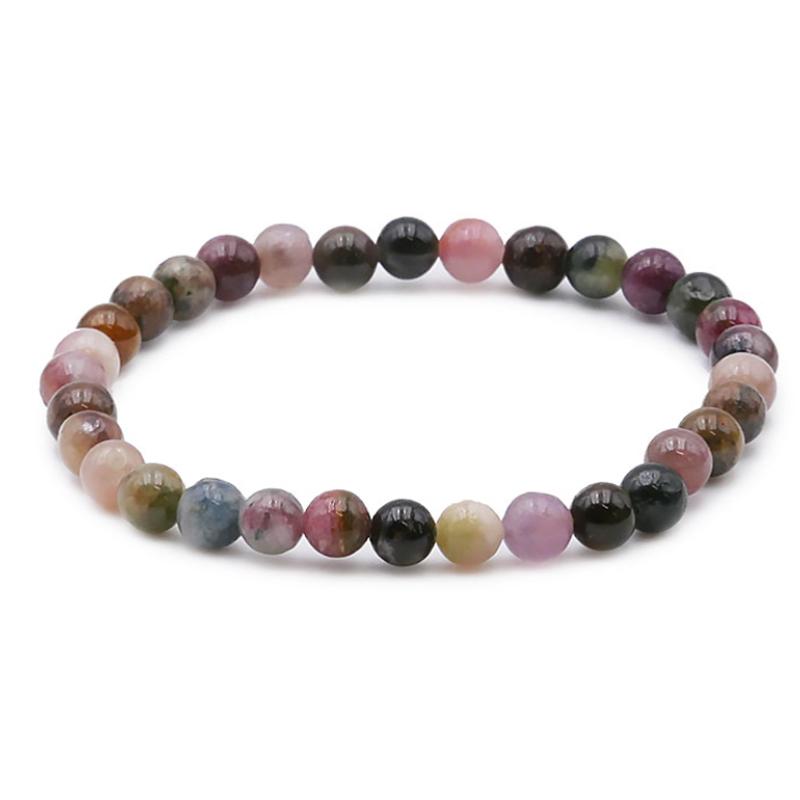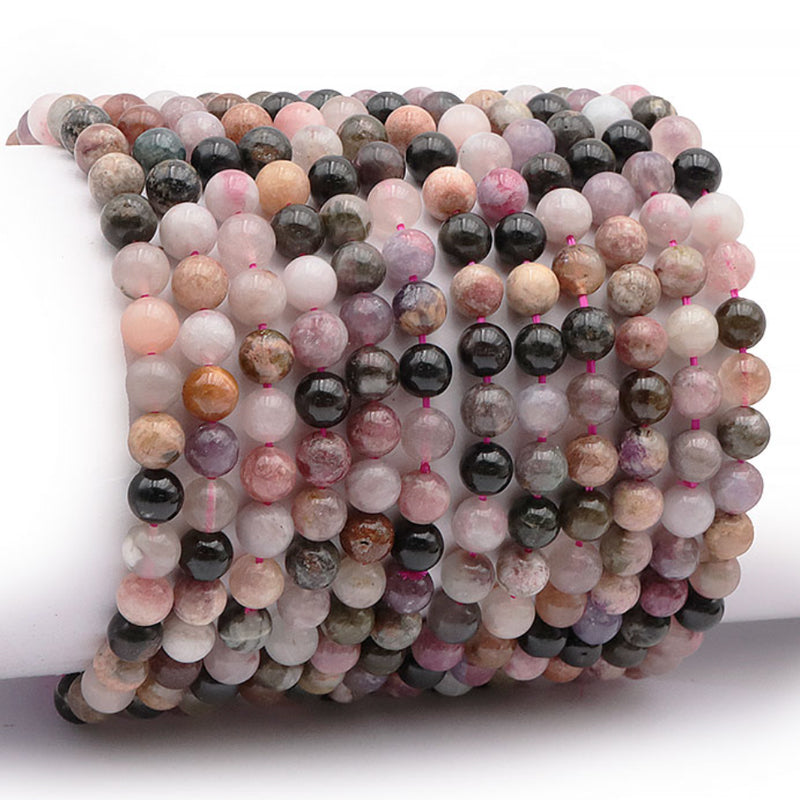Multicolored tourmaline bracelet Brazil AA (5-6mm balls)
BRA-TOUR-25
- Regular price
-
24,90 € - Regular price
-
- Sale price
-
24,90 €
Couldn't load pickup availability
Learn more
BRA-TOUR-25
Origin: Brazil
Grade: AA
Bracelet made of 5-6mm multicolored tourmaline beads
Patterns and colors may vary from bracelet to bracelet
The name tourmaline comes from “turmali” or “turamali” which is actually a Sinhalese name given to this fabulous stone from Sri Lanka by Dutch explorers at the beginning of the 18th century.
In Sri Lanka, legend has it that tourmaline comes from the sky and, as it descends to earth, passes through a rainbow that gives it its color variations. This explains the origin of its name, which means “the stone of a thousand colors.”
In fact, tourmaline has been known for thousands of years. Traces of this stone were found in the 3rd century BC. In Greece, it was Alexander the Great (356-323 BC) who brought this stone back from his expeditions. However, tourmaline, due to its many colors, has very often been confused with other minerals.
Thus, there are very few legends or myths attached to this stone due to its late identification. However, some tourmalines have piezoelectric properties, which means they have an electrical charge, negative at one pole and positive at the other pole. Tourmaline attracts particles to itself.
When the philosopher Theophrastus (-322 to -288) described a stone that had the ability to attract pieces of straw or wood, we understand that he was talking about tourmaline. Later in the 18th century, Dutch explorers used tourmaline to clean their pipes, because the stone attracted ashes.
As an anecdote, in the 16th century, a Spanish conquistador discovered a green tourmaline in Brazil, which he identified as an emerald. This discovery caused a rush in the Brazilian regions in search of these famous emeralds. The error was corrected in the 19th century and the emeralds transformed into tourmalines.
Often mistaken for precious stones, tourmalines are found in many pieces of jewelry, even in the British crown. Other examples include the Timur Ruby, a 352-carat jewel that was thought to be a ruby until 1851, or the 170-carat Black Prince Ruby, which is actually a tourmaline.
Tourmaline is attracting increasing interest from connoisseurs and collectors. The Chinese Empress Cixi (1861-1908) was so fond of this stone that she began collecting it. She commissioned sculptures, brooches, watch clasps, rings, and other items to be made from it. Today, she rests on a cushion of tourmalines.
The main deposits are located in Brazil, Afghanistan, Australia, Brazil, Russia, Thailand, Burma, Madagascar, India, and the United States.
Multicolored tourmalines
Little reminder
Tourmalines come in various shades. They can also be bi-colored or multicolored. There is a wide variety of tourmalines, ranging from opaque to transparent, with striated or hexagonal structures. They have a rhombohedral crystal system. It is an igneous and metamorphic rock that can originate from hydrothermal deposits.
Thus, tourmalines have varied compositions such as magnesium silicates, sodium silicates, iron silicates, clay silicates, fluorides, and borosilicate silicates. Tourmalines are actually a whole family of stones, which have the same internal structure, but differ in chemical composition and therefore in color and appearance.
The tourmaline family is an attractive variety in the world of fine stones. They crystallize in all possible colors. They are highly prized in jewelry because of their high hardness (7 to 7.5). They possess resplendent hues and exceptional brilliance.
The strong birefringence of tourmalines means that no two tourmalines are the same color. Jewelers-designers can therefore offer unique creations of great originality. Gem-quality (transparent) tourmaline will be faceted in various shapes (pear, oval, round, etc.). Translucent to opaque tourmaline of well-defined colors will be cut into cabochons or polished slices.
Tourmalines come in a variety of colors and can be combined to create bracelets or necklaces. Let's take a look at the most commonly used ones.
Blue tourmaline
Blue tourmaline is also known as indigolite or indicolite. It is a stone with a light to dark blue color. It is distinguished from other tourmalines by its transparent appearance in its raw form.
In lithotherapy, it is a stone of calm and serenity. It frees the mind from negative thoughts. It encourages loyalty in love and friendship, as well as honesty. Blue tourmaline dispels feelings of sadness, unease, and despair, making room for positive feelings.
Brown tourmaline
Brown tourmaline or dravite is a variety of tourmaline that is brown or mahogany in color, sometimes so dark that it is confused with black tourmaline. It is a mineral of the cyclosilicate family, hydroxylated with sodium, aluminum, and magnesium.
In lithotherapy, it helps overcome life's difficulties and gives the courage to accept the unthinkable. It allows one to make peace with one's past and identify the origin of certain blockages often linked to childhood. Brown tourmaline is a stone rich in magnesium. It allows its wearer to better fix magnesium during supplementation treatments.
Yellow tourmaline
There are different varieties of yellow tourmaline (Malawi tourmaline, elbaite, tsilaisite, etc.).
It's worth noting that yellow tourmaline is one of the most expensive tourmaline varieties. The price of these yellow tourmalines varies depending on their quality, purity, origin, and weight. A tourmaline set in a ring can cost up to a hundred euros.
In lithotherapy, yellow tourmaline is valued for its energizing properties. It is a stone of dynamism and vitality. It allows people who are mentally and physically tired to regain energy and the will to achieve their goals. An anti-stress stone, it also helps overcome states of intense sadness.
Black tourmaline
Black tourmaline is the most well-known variety of tourmaline. It is also known as schorl. It is said to be black, but it can also be dark brown. It has gained notoriety over time due to its many properties.
It is the most common tourmaline and can sometimes measure up to 2 m in height. Its composition, very rich in iron, gives it this black, opaque and intense appearance.
In lithotherapy, black tourmaline is a powerful grounding stone. It helps keep one's feet on the ground, calms scattered thoughts, and refocuses attention. A formidable anti-stress stone, black tourmaline diffuses energy and vitality.
Cat's Eye Tourmaline
Cat's eye tourmaline is one of the rarest varieties of tourmaline. It is so named because of the light reflection phenomenon reminiscent of a cat's slitted eye. This phenomenon is called chatoyancy.
This optical peculiarity is exceptionally rare and is found in only a handful of fine stones. It is caused by the presence of tiny parallel fibers or needle-like inclusions within the stone.
In lithotherapy, cat's eye tourmaline, like many other tourmalines, repels negative energies. It is an excellent protective stone that helps ward off people with negative influences. It is also known to strengthen the immune system and facilitate the proper circulation of bodily fluids.
Pink tourmaline
Pink tourmaline (or called rubellite when it approaches red) is composed of complex silicates of borosilicates, iron, alkalis, and magnesium. It also contains a high content of copper and manganese, which gives it its beautiful pink color. Pink tourmaline can be transparent, translucent, or even opaque.
Pink tourmaline is a stone often found in association with other minerals. The most common associations are pink tourmaline on eudialyte, pink tourmaline on lepidolite, and pink tourmaline on rose quartz.
In lithotherapy, pink tourmaline is closely linked to feelings of love and tenderness. It emits vibrations that restore and protect psychological well-being. Pink tourmaline brings serenity and allows its wearer to effectively combat stress and its consequences on the body.
Green tourmaline
Green tourmaline is also known as verdelite. It comes in various shades of green, with a transparent appearance. Green tourmaline is the most common after black tourmaline. Less commonly, other green tourmalines, such as chrome tourmalines, can be found. The latter are rarer and more sought-after.
In lithotherapy, the beautiful green colors of this tourmaline evoke the greens present in nature during spring, the season of renewal. It is then said that green tourmaline is excellent for anyone who wants to start anew. It gives them the strength to leave a toxic relationship, a thankless job, etc. Placing a green tourmaline in a bedroom helps to keep away agitated thoughts at bedtime. A softness sets in and promotes sleep.
Features
Color :
- Multicolor
Astrological sign:
- Scorpio
Stone Type:
- Ball Stones
Age :
- Adults
Gender :
- Unisex



Multicolored tourmaline bracelet Brazil AA (5-6mm balls)
- Regular price
-
24,90 € - Regular price
-
- Sale price
-
24,90 €
-
100% SECURE PAYMENT
Paypal, credit card, check, transfer
-
FREE DELIVERY
from 40€ purchase
-
SATISFIED OR REFUNDED
14 days to change your mind
-
CUSTOMER SERVICE AVAILABLE
contact@laboiteacailloux.com
to receive all our offers, good deals and new products from La Boite à Cailloux




